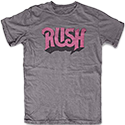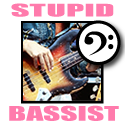|
thegloaming posted:So I'm kind of starting over completely by adopting the "floating thumb" technique. Before I was doing the whole anchoring thing except I was moving my thumb down and resting it on the strings as I strummed the higher ones (this is the method outlined in Hal Leonard Bass Method). So far it feels a little odd relying on the shoulder muscles so much (not uncomfortable, though), but I'm hoping a few days of practice will get me back up to speed. That's essentially what floating is... Not anchored to any one area the whole time.
|
|
|
|

|
| # ? May 12, 2024 19:48 |
|
Scarf posted:That's essentially what floating is... Not anchored to any one area the whole time. Right, but before it was essentially a moving anchor where I would rest my thumb like this: strumming E, resting thumb on top of pickup strumming A, resting thumb on top of pickup strumming D, resting thumb on top of E strumming G, resting thumb on top of A I was still putting tension in my wrist when I anchored. Now I just let the thumb "float" over the strings and it mutes them naturally:  Now my wrist is much more straight and relaxed (I lowered my strap a little and the shoulder movements are much easier now). Is there anything wrong with this? Also, Scarf, could you take a look at the new OP and let me know what you think? Your input would be greatly appreciated, especially since I got a lot of the information from you.
|
|
|
|
thegloaming posted:Right, but before it was essentially a moving anchor where I would rest my thumb like this: My point was that you were essentially floating in the first place (at least I consider that floating) by changing the anchor point depending on what strings you're playing. But if you were still putting too much pressure on your thumb/wrist when anchoring, I can see where that'd cause some discomfort. Haha I guess now you're not just floating you're free-floating or something like that... quote:I was still putting tension in my wrist when I anchored. Now I just let the thumb "float" over the strings and it mutes them naturally: If it has alleviated the problem then go for it! I personally still play with my bass somewhat high, centered around my belly button/just above my belt. So I have the classic bent-wrist. But I think I've just gotten used to it. I can't really see any benefit of doing it one way or the other, it just depends on what works for you. Obviously if it was causing you pain before, then it wasn't for you. If this setup works out well for you, then yeah, you're doing it right  quote:Also, Scarf, could you take a look at the new OP and let me know what you think? Your input would be greatly appreciated, especially since I got a lot of the information from you.
|
|
|
|
Oh, I'll come up with a good blurb about different techniques to sound the bass (finger, pick, thumb, slap, etc.). Since it's always a heated discussion revolving around it. I'll have something this afternoon.
|
|
|
|
Scarf posted:Oh, I'll come up with a good blurb about different techniques to sound the bass (finger, pick, thumb, slap, etc.). Since it's always a heated discussion revolving around it. I'll have something this afternoon. Sounds good! I'll keep a look out. Right, I suppose I was still "floating" with the old technique, and while it wasn't necessarily uncomfortable, the new technique requires a lot less effort, and I really want to instill a sense of looseness and calm in my playing. Anyway, thanks for the advice and I'll keep at it!
|
|
|
|
edit: poo poo, hit submit instead of preview... i'll repost when im done.
|
|
|
|
I'll try and keep this somewhat brief, but there are entire books written on sounding technique alone... Generally speaking there are three major/basic techniques for sounding the notes on a bass guitar: Finger-picking (Fingering, plucking, finger-style, etc.), Flat-Picking (Picking, pick-style), Slapping (Slap and pop, thumping, etc.). Finger-picking/Plucking In my opinion, finger-picking is by far the most common and most versatile method for sounding notes on a bass guitar. This technique involves a player using their fingers to pluck the string along the playing surface, generally thought of being between the bridge and where the neck joins the body of the instrument. This is most commonly done with the index and middle fingers, however there are several notable players who make use of their ring-fingers and thumbs to pluck notes as well. The pinky is sometimes used if sounding a chord or performing finger-picking more closely related to what you would see on a guitar. This technique has its roots in the pizzicato technique often used for orchestral stringed instruments to produce a short, more percussive sound than that generated by using a bow. It became more common among bassists during the early bluegrass and jazz eras, where the upright bass not only covered the lower register of notes in the music but took on more of a rhythmic role in terms of the actual time-keeping and tempo. However, with the development of the modern electric bass guitar, notes that are sounded through finger-picking are no longer limited to being short, or even percussive. The sustain of the note, as well as the attack (percussiveness) can vary depending on a number of factors when it comes to finger-picking, hence the versatility of the technique. By using the very tips of the fingers to pluck the strings, you can get a much more pronounced and almost percussive sound. On the other hand, if you use the pads if your fingers, a much mellower/smoother sound is achieved. I've found the smoothest (albeit less defined) sound comes from plucking with the pad of the thumb. However, famous punk bassist Mike Watt developed a technique which he called the "flipper," using the pads of all 4 fingers at once to get an even smoother, more mellow sound. This is also dependent on where you pluck the strings along the playing area. The strings get tighter closer to the bridge, so plucking there will result in a tighter, almost thinner sound. Whereas plucking closer to the neck where the strings are looser will result in a looser, less-defined but more full sound. Combine these two concepts (finger placement and finger technique) can give you a multitude of different tones. For example, if you want a classic reggae tone with virtually no definition to it (aside from any kind of EQ adjustments on the electronics) try plucking with the pad of your thumb up close to the neck joint. The complete opposite of that would be more modern jazz and pop sound produced by using the finger tips near the bridge. Flat-Picking/Picking Picking on the bass guitar likely came about as a result of many guitarists giving the instrument a shot and just being much more comfortable with a pick. Picking results in a much clearer, more distinctive note than with finger-picking. While not as versatile as finger-picking, you can still get a wide range of tones from picking. Again this will depend on where you pick in the playing area, but the type of string, the type of pick, and the amount of force with which you pick will also have an impact. Picking with roundwound strings will produce a very bright, and sometimes "twangy" sound with lots of overtones whereas picking with flatwound strings will result in more of a "plunk." And again, picking near the neck will result in a less defined sound, while picking near the bridge will give an almost piano-like clarity to the notes. Using a pick also allows the player easier access to their palm for muting purposes. This can be used to almost immediately silence a note after its been sounded, or to produce an even more "plunky" sound by muting and picking at the same time. Picking is commonly used in rock, hardrock, metal, and punk genres due the very bright, and grinding like sound you can get from picking forcefully, especially on basses equipped with humbucking pickups, like a P-bass. But that isn't to say that picking is limited to these styles of music. Notable bass players who have been known to make use of a pick at one time or another include: Paul McCartney (Beatles), Allen Woody (Gov't Mule, Allman Bros.), George Porter Jr. (The Meters), John Entwistle (The Who), Phil Lynott (Thin Lizzy), Phil Lesh (Grateful Dead), Mike Gordon (Phish), Chris Squire (Yes), Rick Danko (The Band), John Paul Jones (Led Zeppelin), and the list goes on. Slap/Pop/Thump While slap bass has roots in the upright bass world to the early days of jazz, slap bass in terms of the electric bass guitar (originally referred to as "Thumping" in the 70s) and its creation is usually attributed to Larry Graham of Sly and the Family Stone and later Graham Central Station in the 1970s. Graham has stated several times that he was trying to emulate the sound of a drum before the band had found its drummer. Slap bass is an incredibly percussive style of playing and heavily based on rhythm. It involves essentially two techniques, the slap and the pop. The slap is typically using the thumb of the sounding hand to strike the desired string (usually around where the body meets the neck), causing it to hit the fretboard, thus resulting in a very defined and percussive sound. The "pop" involves using a finger to pluck a string forcefully from underneath and releasing it, causing it to, again, strike the fretboard. The two are used in conjunction with each other, usually in sequences and successions to produce almost drum-like rhythms on the bass. I like to think about it like a drumkit... the Slap is usually a hit on the kick-drum, where the Pop is more like a snare hit. There are also more advanced techniques to slapping such as Double-Thumping, and the ability to do multiple-pops in succession using several fingers. Slap bass is commonly seen in more modern funk, funk-rock, and some jazz fusion. It has even found its way into some metal and hard rock. Notable slap players include: Larry Graham, Marcus Miller, Stanley Clarke, Les Claypool, Flea, Victor Wooten, etc. That's all I got in me for now, if anyone wants to add to any of that, feel free.
|
|
|
|
Looks good, Scarf. I went ahead and added it to the OP. By the way, I'm curious about 3+ finger plucking techniques. Could you elaborate on those a little more? Would a new player want to bother with these techniques? Why or why not? Who are some famous bassists who use these techniques? Rush_shirt fucked around with this message at 22:06 on Jul 9, 2009 |
|
|
|
I think there's two main uses for it- one for speed, the other for quick access to all strings. I use 3 fingers for speed, it's not uncommon to do runs of about 12 notes a second, or mixing up regular beats with triplets/quintuplets thrown in. The other technique is one that still amazes me (read: I have no skill at it) which is using one finger per string, much like an oldschool fingerpick guitarist would. They can jump over strings with precision.
|
|
|
|
thegloaming posted:By the way, I'm curious about 3+ finger plucking techniques. Could you elaborate on those a little more? Would a new player want to bother with these techniques? Why or why not? Who are some famous bassists who use these techniques? The most famous is probably Entwistle, who used all four at once. He wasn't called Thunderfingers for nothing. I personally use three because it feels the most natural. I started with two and then after a couple of months I could just feel my third finger wanting to get in there. After a few more I tried putting my little finger in there as well but it was a real struggle to get any control over it, so I stopped and it now does emergency muting duty.
|
|
|
|
thegloaming posted:Looks good, Scarf. I went ahead and added it to the OP. John Entwistle of The Who is the most famous. He'd throw around quick triplets like nobody's business. The easiest way to do the triplets, in my experience, is to start with the ring finger, followed by the middle, and then the index. It's kind of like drumming on a desk with your fingers. https://www.youtube.com/watch?v=w5mFVo55bKQ That's a little over the top... but that's how Entwistle played.
|
|
|
|
Here's a quick and dirty little riff with me using some triplets like that.
|
|
|
|
Thanks for the information and links. I've been doing some youtube research and all I can find for four finger playing is with the thumb, index, middle and ring. Has anyone ever successfully pulled off an index, middle, ring, pinky configuration? I figure since I'm spending the time to step back and really refine my technique, I might want to try working 3+ finger strumming. It certainly seems like its less effort (playing, not learning) for a great speed increase. EDIT: Entwistle obviously is an example of the imrp config. Rush_shirt fucked around with this message at 00:20 on Jul 10, 2009 |
|
|
|
Billy Sheehan also uses three-finger technique. I think possibly Alphonso Johnson does as well.
|
|
|
|
I'm not a bassist and it's not rock or a bass guitar, but I feel like Niels-Henning ěrsted Pedersen deserves a little bit of a mention here. 2:35 to the end of http://www.youtube.com/watch?v=yI-1sq5dFD4, for instance.
|
|
|
|
Here's a sample of me doing the triplet thing I was talking about, first slow and then fast. Mildly muddy, sorry bout that.
|
|
|
|
thegloaming posted:Thanks for the information and links. I have, but never really followed up much on it because it hampered my normal technique. Basically I wear the bass very low (below my waist) and you really need to be wearing the bass pretty high as you have to angle your hand in such a way that all four fingers are pretty much the same length. I'd strike the strings in the order of ring, middle, index and then pinky, it was just a case of getting the pinky up to strength as well so it didn't sound weaker. But as I said I never went too far with it because I prefered wearing the bass low and if I wanted to play really fast I'd just bring out the pick.
|
|
|
|
NarkyBark posted:Here's a sample of me doing the triplet thing I was talking about, first slow and then fast. Mildly muddy, sorry bout that. Interesting tone on that, the attack of the notes surprised me. What gear are you using?
|
|
|
|
That's not a normal setup for me, that's just a quick recording, which is just miking an amp with a usb interface, playing a warwick rockbass. My usual sound is really very sharp and twangy; I play metal and my sound is very percussive, which is pretty much the reason why I bother doing those triplets and stuff in the first place since you'd never hear them with a plain low-end sound.
|
|
|
|
Seventh Arrow posted:Billy Sheehan also uses three-finger technique. I think possibly Alphonso Johnson does as well. This should be mentioned along with Scarf's descriptions in the OP: Billy Sheehan's three finger technique is all about speed and consistency. His theory is to use the first three fingers and bend them at the second knuckle. When bent, the fingers are all the same length creating an even pattern for striking notes. This is illustrated in his own lesson here: http://www.youtube.com/watch?v=ruTSsawJpcU Also... Thumbing technique - used in a lot of reggae and also used by Sting. Using the outside of the thumb, push down to create the notes, but not down into the bass guitar itself. Place palm of hand on the E-string and bridge creating a muffled or muted tone. In Reggae form in a lsson from Ed Friedland here: http://www.youtube.com/watch?v=0-dAZrBlGOY Ed also has a lesson on palm muting, which utilizes the thumb here: http://www.youtube.com/watch?v=RYceQadUXTI Also... Regarding floating thumb technique - link to this video by Todd Johnson: http://www.youtube.com/watch?v=PPVMBPmrblU Schatten fucked around with this message at 19:02 on Jul 10, 2009 |
|
|
|
So I'm encountering some issues regarding proper left hand (fretting) technique: I've never been able to gracefully fret the neck, even when I played guitar. This problem was obviously exacerbated when I moved to bass. I want to feel comfortable in a one-finger-per-fret configuration; unfortunately, doing this even at the higher frets feels very unnatural. Whether or not this is because my fingers aren't used to stretching out is anyone's guess. I've attached a picture demonstrating my problem. In it, I'm trying to compensate for "proper technique" (one finger per fret, pads of fingers placed just behind frets, thumb against back of neck, etc.) and as you can tell it's not very comfortable or pretty. It's not relaxing and again, I'm not sure if this is due to poor playing before and I'm just not used to it or if I'm barking up the tree and need to find a technique that's comfortable for me. Any pointers? I can provide more pictures and information if needed.
|
|
|
|
Try this http://www.youtube.com/watch?v=y57-2eaTBwc&NR=1 Don't worry about quick progress though. It takes a long time for the tendons and muscles to learn how to stretch and relax enough to really reach those low notes with the 1 finger per fret system. Just start easy and slow and work your way up. Doing it with a metronome would be ideal because that way you can practice your rhythm at the same time.
|
|
|
|
Plastic Snake posted:Try this http://www.youtube.com/watch?v=y57-2eaTBwc&NR=1 I'm definitely concerned with getting it right over getting it quick. I had been playing casually for about 1.5 years and I realized that my technique needed a lot of changes. I'm pretty much starting over from ground zero and I'm prepared to take a couple months just getting both hands working right before moving onto anything more complex. Thanks for the link. I think my hands might just be weird or something. I tried going over it with a teacher a while ago and I think we eventually just sort of settled on a technique that works for guitar but doesn't really for bass.
|
|
|
|
thegloaming posted:So I'm encountering some issues regarding proper left hand (fretting) technique: Try bringing your elbow in closer to your body. Your entire hand doesn't need to be hovering above the fretboard the whole time. Pull your elbow back some, let your wrist straighten out.
|
|
|
|
Good glory, Jamerson was just the man...found this track of just him supporting an entire vocal arrangement, and the whole thing is melodic and perfect all the way through. Awesome https://www.youtube.com/watch?v=uCrO3iVWZE8
|
|
|
|
Trip report on four finger plucking: gaining independence between your hands isn't easy. This isn't a problem when I'm playing a 1-2-3-4, but when I play something like 1-3-2-4, my plucking hand naturally wants to match my fretting hand. I'm working out the kinks by practicing on a low tempo; I'm trying to have my strumming be a constant forward moving index-middle-ring-pinky wave.
|
|
|
|
Ugh, 4-finger plucking is rough. When I first went to college, I started taking lessons from a guy who plucked with 4 fingers...he was amazing, he could play bebop solos, fast violin etudes, all of that kind of stuff. My problem was that I had only been playing a few years at the time, so I think it was too much to handle. I eventually dropped it for the usual 2-finger method. To think I was practicing 12-16 hours a day at the time, and it could've been better spent if my right hand technique weren't so high-maintenance.
|
|
|
|
Also, I just realized that a big problem with my fretting technique was that the bass was hanging too low on the strap. Because of the way my strap's designed, even the shortest setting isn't short enough for me, so I'm going to have to buy a new strap. For now, I'll just sit down when I practice.
|
|
|
|
Hey bass goons, I have lerked here for a bit and read good things about EBS pedals. I want the multi-comp but is it worth the $200 to have a GOOD compressor, or should I get a basic $70 one as my first comp pedal? Will I tell a difference? I just stepped up to a 3X10 combo that sounds good but my mids and highs are not punching through enough if I really drive the low end. This is what I need to even out my sound, right?
|
|
|
|
thegloaming posted:Also, I just realized that a big problem with my fretting technique was that the bass was hanging too low on the strap. Because of the way my strap's designed, even the shortest setting isn't short enough for me, so I'm going to have to buy a new strap. For now, I'll just sit down when I practice.
|
|
|
|
Schatten posted:I require a shorter strap than usual on most of my guitars and basses. But I still sling a little low and vary in length depending on what I'm playing and how I'm playing it. When buying a strap, sling it over your shoulder and see if it is short enough. If it is a heavy bass, you should look into the comfort strap or something similar. I think the problem with the one I have now is that the shoulder pad is too big and it can't be raised past the point where the pad begins. I'll have to find something that's suitable for scrawny guys like me.
|
|
|
|
Nice thread title 
|
|
|
|
Cortel posted:Nice thread title quit posting and work on your cheek strumming
|
|
|
|
I posted this on Talkbass, but I figured it might do some good here as well...it's a brief lesson on walking basslines: I'm starting this thread because every now and then I see people asking either how they can make walking bass lines, or how they can get better at walking bass lines. When I was in college (and dinosaurs roamed the earth), my teacher suggested keeping a library of walking bass "licks" in order to keep my walking lines interesting and not as repetitive. Just like a saxophonist might use the Charlie Parker Omnibook so as to have some soloing licks at the ready, bassists can also use walking bass "licks" or phrases to navigate through even the more angular jazz chord progressions. So I decided to post some from my own collection, and I hope people learning this stuff will come up with more of their own. I'm not any sort of jazz pro, although I have played a great many of these before guys like Pat Labarbera, Don Thompson, and Charles Tolliver with no complaints. Some notes: 1. Most of these (except for the rhythm changes and modal sheets) are collections of discreet, two-bar phrases. So don't look at them as one big page of continuous II-V (for example) vamps...sorry if that's confusing. 2. Because of that, the accidentals usually reset every two bars...oops. Again, sorry about that. 3. The naming convention is a bit weird, but I wasn't sure where to go with that. The page that's called "II-V basslines", well obviously you can also use that for I-IV or III-VI chord progressions too...I just wanted to present the different ways that a walking line can get from point A to point B. 4. You'll notice that not all the lines start off on the root. You're allowed to do this, believe it or not! But, you have to use your ears and discretion. It can depend on some factors, like tempo, style, what kind of band you're playing for, etc. Some of the walking lines have more emphasis on making a nice "shape" rather than spelling out the chord exactly...there's stuff here that will be easier to get away with at 300 bpm rather than 70 bpm. 5. You'll notice some repetition, mostly because my emphasis will be on getting from point A to point B, and not necessarily on getting from point B to point C. 6. Make sure to transcribe from the masters! So here's the II-V licks:   Here are the pages for I-II-(V) Bb7-A7-(Dm7) type chord progressions I-VI-(II) chord progressions IV7-#IVdim-(I) chord progressions Bb7-C7-Fm type chord progressions I-IIIm7-(VI7) chord progressions I7-V7-(I7) chord progressions Walking lines for repeating chords Rhythm changes (mostly eight bar phrases) Modal (four bar phrases)
|
|
|
|
Seventh Arrow posted:Awesome Stuff Thanks a lot for this. For a hobby player like me, this is gold.
|
|
|
|
How much would a 30W solid state bass amp with a chromatic tuner be worth? I have no idea and I don't want to get ripped off
|
|
|
|
bitches aint poo poo posted:How much would a 30W solid state bass amp with a chromatic tuner be worth? I have no idea and I don't want to get ripped off It can really vary. Do you know what brand of amp it is? For 30 watts though I would say no more than 100 bucks, there's not a whole lot you can do with that other than practice.
|
|
|
|
Seventh Arrow posted:walking basslines As a guitarist who has been trying to expand my bass chops a bit, this is incredibly useful on several levels. Thank you so much for posting these!
|
|
|
|
Plastic Snake posted:It can really vary. Do you know what brand of amp it is? For 30 watts though I would say no more than 100 bucks, there's not a whole lot you can do with that other than practice. Not sure what brand it is, but the guy is pretty trustworthy and has plenty of musical knowledge. He asked for $100 for it. But if I could buy a 30W brand new for $100.... I'll have to ask what brand it is. I imagine it's not a low end or crappy brand because he plays bass but...
|
|
|
|

|
| # ? May 12, 2024 19:48 |
|
bitches aint poo poo posted:I imagine it's not a low end or crappy brand because he plays bass but... That's not an assumption you should make!
|
|
|















